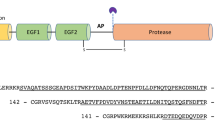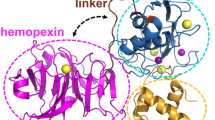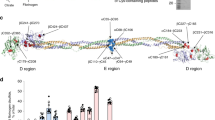Abstract
In blood coagulation, units of the protein fibrinogen pack together to form a fibrin clot, but a crystal structure for fibrinogen is needed to understand how this is achieved. The structure of a core fragment (fragment D) from human fibrinogen has now been determined to 2.9 Å resolution. The 86K three-chained structure consists of a coiled-coil region and two homologous globular entities oriented at approximately 130 degrees to each other. Additionally, the covalently bound dimer of fragment D, known as ‘double-D’, was isolated from human fibrin, crystallized in the presence of a Gly-Pro-Arg-Pro-amide peptide ligand, which simulates the donor polymerization site, and its structure solved by molecular replacement with the model of fragment D.
This is a preview of subscription content, access via your institution
Access options
Subscribe to this journal
Receive 51 print issues and online access
$199.00 per year
only $3.90 per issue
Buy this article
- Purchase on Springer Link
- Instant access to full article PDF
Prices may be subject to local taxes which are calculated during checkout













Similar content being viewed by others
References
Bailey, K., Astbury, W. T. & Rudall, K. M. Fibrinogen and fibrin as members of the keratin–myosin group. Nature 151, 716–717 (1943).
Hall, C. E. & Slayter, H. S. The fibrinogen molecule: its size, shape and mode of polymerization. J. Biophys. Biochem. Cytol. 5, 11–15 (1959).
Cohen, C. Invited discussion at 1960 Symposium on Protein Structure. J. Polymer Sci. 49, 144–145 (1961).
Doolittle, R. F., Cassman, K. G., Cottrell, B. A., Friezner, S. J. & Takagi, T. Amino acid sequence studies on the α-chain of human fibrinogen. The covalent structure of the α-chain portion of fragment D. Biochemistry 16, 1710–1710 (1977).
Laudano, A. P. & Doolittle, R. F. Studies on synthetic peptides that bind to fibrinogen and prevent fibrin polymerization. Structural requirements, numbers of binding sites and species differences. Biochemistry 19, 1013–1019 (1980).
Chen, R. & Doolittle, R. F. γ–γ Crosslinking sites in human and bovine fibrin. Biochemistry 10, 4486–4491 (1971).
Pizzo, S. V., Schwartz, M. L., Hill, R. L. & McKee, P. A. The effects of plasmin on the subunit structure of human fibrin. J. Biol. Chem. 248, 4574–4583 (1973).
Hudry-Clergeon, G., Patural, L. & Suscillon, M. Identification d'un complexe (D-D) E dans les produits de dégradation de la fibrine bovine stabilisee par le facteur XIII. Pathol. Biol. 22 (suppl.), 47–52 (1974).
Rao, S. P. S. et al. Fibrinogen structure in projection at 18 Å resolution electron density by co-ordinated cryo-electron microscopy and X-ray crystallography. J. Mol. Biol. 222, 89–98 (1992).
Yee, V. C. et al. Crystal structure of a 30 kDa C-terminal fragment from the γ chain of human fibrinogen. Structure 5, 125–138 (1997).
Dang, C. V., Ebert, R. F. & Bell, W. R. Localization of a fibrinogen calcium binding site between γ-subunit positions 311 and 336 by terbium fluorescence. J. Biol. Chem. 260, 9713–9717 (1985).
Townsend, R. R. et al. Carbohydrate structure of human fibrinogen. J. Biol. Chem. 257, 9704–9710 (1982).
Bullough, P. A., Hughson, F. M., Skehel, J. J. & Wiley, D. C. Structure of the influenza haemagglutinin at the pH of membrane fusion. Nature 371, 37–43 (1994).
Bouma, H. II, Takagi, T. & Doolittle, R. F. The arrangement of disulfide bonds in fragment D from human fibrinogen. Thromb. Res. 13, 557–562 (1978).
Doolittle, R. F. Adetailed consideration of a principal domain of vertebrate fibrinogen and its relatives. Protein Sci. 1, 1563–1577 (1992).
Yamazumi, K. & Doolittle, R. F. Photoaffinity labeling of the primary fibrin polymerization site: Localization of the label to tyrosine γ-chain Tyr-363. Proc. Natl Acad. Sci. USA 89, 2893–2896 (1992).
Gerloff, D. E., Cohen, F. E. & Benner, S. A. Apredicted consensus structure for the C terminus of the β and γ chains of fibrinogen. Proteins Struct. Funct. Genet. 27, 279–289 (1997).
Okumura, N. et al. Fibrinogen Matsumoto I: a γ364 Asp ≫ His (GAT to AT) substitution associated with defective fibrin polymerization. Thromb. Haemost. 75, 887–891 (1996).
Ebert, R.. F. (ed.) 1994 Index of Variant Human Fibrinogens (CRC Press, Boca Raton, FL, (1994)).
Janin, J., Miller, S. & Chothia, C. Surface, subunit interfaces and interior of oligomeric proteins. J. Mol. Biol. 204, 155–164 (1988).
Mosesson, M. W. et al. The role of fibrinogen D domain intermolecular associaiton sites in the polymerization of fibrin and fibrinogen Tokyo II (γ275 Arg to Cys). J. Clin. Invest. 96, 1053–1058 (1995).
Donahue, J. P., Patel, H., Anderson, W. F. & Hawiger, J. Three-dimensional structure of the platelet integrin recognition segment of the fibrinogen γ chain obtained by carrier protein-driven crystallization. Proc. Natl Acad. Sci. USA 92, 12178–12182 (1994).
Weisel, J. W., Francis, C. W., Nagaswami, C. & Marder, V. J. Determination of the topology of factor XIIIa-induced fibrin γ-chain cross-links by electron microscopy of ligated fragments. J. Biol. Chem. 268, 26618–26624 (1993).
Mosesson, M. W., Siebenlist, K. R., Hainfeld, J. F. & Wall, J. S. The covalent structure of factor XIIIa crosslinked fibrinogen fibrils. J. Struct. Biol. 115, 88–101 (1995).
Mosesson, M. W., Siebenlist, K. R., Amrani, D. L. & DiOrio, J. P. Identification of covalently linked trimeric and tetrameric D domains in crosslinked fibrin. Proc. Natl Acad. Sci. USA 86, 1113–1117 (1989).
Siebenlist, K. R., Meh, D. A. & Mosesson, M. W. Plasma factor XIII binds specifically to fibrinogen molecules containing γ′ chains. Biochemistry 35, 10448–10453 (1996).
Mosesson, M. W., Hainfeld, J., Wall, J. & Haschemeyer, R. H. Identification and mass analysis of human fibrinogen molecules and their domains by scanning transmission electron microscopy. J. Mol. Biol. 153, 695–718 (1981).
Veklich, Y. I., Gorkun, O. V., Medved, L. V., Nieuvenhuizen, W. & Weisel, J. W. Carboxyl-terminal portions of the α chains of fibrinogen and fibrin. Localization by electron microscopy and the effects of isolated αC fragments on polymerization. J. Biol. Chem. 268, 13577–13585 (1993).
Schielen, W. J. G., Adams, H. P. H. M., Voskuilen, M., Tesser, G. J. & Nieuwenhuizen, W. Structural requirements of position Aα-157 in fibrinogen for the fibrin-induced rate enhancement of the activation of plasminogen by tissue-type plasminogen activator. Biochem. J. 276, 655–659 (1991).
Nieuwenhuizen, W., Vermond, A., Voskuilen, M., Traas, D. W. & Verheijen, J. H. Identification of a site in fibrin(ogen) which is involved in the acceleration of plasminogen activation by tissue-type plasminogen activator. Biochim. Biophys. Acta 748, 86–92 (1983).
Pratt, K. P. et al. The primary fibrin polymerization pocket: three-dimensional structure of a 30-kDa C-terminal γ chain fragment complexed with the peptide Gly-Pro-Arg-Pro. Proc. Natl Acad. Sci. USA 94, 7176–7181 (1997).
Mihalyi, E. & Godfrey, J. E. Digestion of fibrinogen by trypsin. II. Characterization of the large fragment obtained. Biochim. Biophys. Acta 67, 90–103 (1963).
Everse, S. J., Pelletier, H. & Doolittle, R. F. Crystallization of fragment D from human fibrinogen. Protein Sci. 4, 1013–1016 (1995).
Otwinowski, Z. & Minor, W. Processing of X-ray diffraction data collected in oscillation mode. Methods Enzymol. 276, 307–326 (1997).
Collaborative Computing Project Number 4 The CCP4 suite: Programs for Protein Crystallography Version 3.1. Acta Crystallogr. D 50, 760–763 (1994).
Furey, W. & Swaminathan, S. Phases 95: A program package for processing and analyzing diffraction data from macromolecules. Methods Enzymol. (in the press).
Stein, P. E. et al. The crystal structure of pertussis toxin. Structure 2, 45–57 (1994).
Kleywegt, G. J. & Jones, T. A. From first map to final model. Joint CCP4 and ESF-EACBM. Newslett. Protein Crystallogr. 31, 59–66 (1994).
Jones, T. A., Zou, J.-Y., Cowan, S. W. & Kjeldgaard, M. Improved methods for building protein models in electron density maps and the location of errors in these models. Acta Crystallogr. A 47, 110–119 (1991).
Brunger, A. T. X-PLOR. Version 3.1. A System for X-ray Crystallography and NMR (Yale Univ. Press, New Haven, CT, (1992)).
Read, R. J. Improved Fourier coefficients for maps using phases from partial structures with errors. Acta Crystallogr. A 42, 140–149 (1986).
Holm, L. & Sander, C. Protein structure comparison by alignment of distance matrices. J. Mol. Biol. 233, 123–138 (1993).
Kraulis, P. J. MOLSCRIPT: a program to produce both detailed and schematic plots of protein structures. J. Appl. Crystallogr. 24, 946–950 (1991).
Esnouf, R. M. An extensively modified version of Molscript which includes greatly enhanced colouring capabilities. J. Mol. Graphics 15, 133–138 (1997).
Bacon, D. J. & Anderson, W. F. Afast algorithm for rendering space-filling molecule pictures. J. Mol. Graphics 6, 219–220 (1988).
Merritt, E. A. & Murphy, M. E. P. Raster3D verison 2.0: a program for photorealistic molecular graphics. Acta Crystallogr. D 50, 869–873 (1994).
Nicholls, A., Sharp, K. & Honig, B. Protein folding and association: insights from the interfacial and thermodynamic properties of hydrocarbons. Proteins Struct. Funct. Genet. 11, 281–296 (1991).
Barton, G. J. ALSCRIPT: a tool to format multiple sequence alignments. Protein Eng. 6, 37–40 (1993).
Pan, Y. & Doolittle, R. F. cDNA sequence of a second fibrinogen α chain in lamprey: an archetypal version alignable with full-length β and γ chains. Proc. Natl Acad. Sci. USA 89, 2066–2070 (1992).
Fu, Y., Cao, Y., Hertzberg, K. M. & Grieninger, G. Fibrinogen α genes: conservation of bipartite transcripts and carboxy-terminal-extended α subunits in vertebrates. Genomics 30, 71–76 (1995).
Acknowledgements
We thank J. Kraut for the use of his X-ray faciities; M. Sawaya for his time; H.Pelletier for help in establishing the initial crystallization conditions; D. Stuart for assistance; N. Xuong and J. Noel for access to equipment; R. Sweet at the Brookhaven National Laboratory for assistance; G.Walter for encouragement; and M. Riley and L. Veerapandian for technical assistance. This work was supported by an NIH grant and an American Heart Association postdoctoral fellowship to S.J.E.
Author information
Authors and Affiliations
Corresponding author
Rights and permissions
About this article
Cite this article
Spraggon, G., Everse, S. & Doolittle, R. Crystal structures of fragment D from human fibrinogen and its crosslinked counterpart from fibrin. Nature 389, 455–462 (1997). https://doi.org/10.1038/38947
Received:
Accepted:
Issue Date:
DOI: https://doi.org/10.1038/38947
This article is cited by
-
Engineered Molecular Therapeutics Targeting Fibrin and the Coagulation System: a Biophysical Perspective
Biophysical Reviews (2022)
-
Congenital hypodysfibrinogenemia associated with a novel deletion of three residues (γAla289_Asp291del) in fibrinogen
Journal of Thrombosis and Thrombolysis (2018)
-
A novel fibrinogen variant: dysfibrinogenemia associated with γAsp185Asn substitution
Journal of Thrombosis and Thrombolysis (2017)
-
Modeling thrombin generation: plasma composition based approach
Journal of Thrombosis and Thrombolysis (2014)
-
Streptococcal M1 protein constructs a pathological host fibrinogen network
Nature (2011)
Comments
By submitting a comment you agree to abide by our Terms and Community Guidelines. If you find something abusive or that does not comply with our terms or guidelines please flag it as inappropriate.



